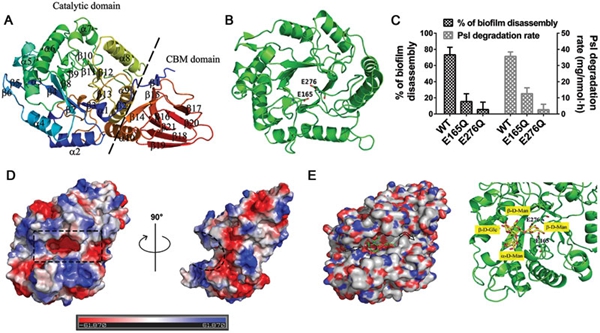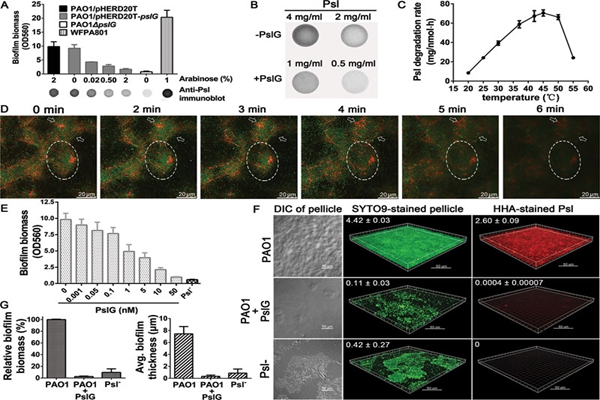On November 27, A research paper entitled “PslG, a self-produced glycosyl hydrolase, triggers biofilm disassembly by disrupting exopolysaccharide matrix” was published inCell Research. This work is an important achievement performed through close collaboration of Prof. Gu Lichuan’s lab (State Key Lab of Microbial Technology at the School of Life Sciences) and Prof. Ma Luyan’s lab (Institute of Microbiology, Chinese Academy of Sciences). Their paper reported the discovery of a self-generated enzyme from Pseudomonas aeruginosa PAO1, PslG, which is able to inhibit the biofilm formation and disrupt a pre-formed biofilm when supplied exogenously.

Biofilms are surface-associated communities of microorganism embedded in extracellular matrix. Cells of opportunistic pathogen Pseudomonas aeruginosa can form biofilms in a variety of situations. Biofilm infections are difficult to treat because bacteria in biofilms tend to be highly resistant to antimicrobial treatment and are able to more easily evade immune responses than planktonic cells. Exopolysaccharide is a critical component in the extracellular matrix that maintains biofilm architecture and protects biofilm bacteria from antimicrobials. However, factors that target the matrix exopolysaccharides are poorly understood.

In this work, the authors solved the crystal structure of PslG, a protein involved in the synthesis of a key exopolysaccharide Psl in Pseudomonas aeruginosa, which showed typical features of an endoglycosidase. Further experiments showed that PslG prevented biofilm formation and disassembled existing biofilms within minutes at nanomolar concentrations when supplied exogenously. Biochemical data showed that PslG mainly targeted the Psl matrix. PslG treatment markedly enhanced biofilm sensitivity to antibiotics and macrophage cells. They also proposed a model which represented the binding of Psl to the catalytic site of PslG, and revealed the putative cleave site.
This work may offer a general strategy to prevent the clinical and environmental complications associated with biofilms, and a patent application on the use of PslG has been filed. Currently, molecular modification of PslG based on its structure has been carried out in Gu’s lab, and a mutant that is resistant to protease degradation has been obtained. This is of great significance for PslG to be used in various environments. Furthermore, cooperative researches with different labs of medicine, environment and marine are underway.
The work was mainly accomplished by Shandong University and Institute of Microbiology jointly. Researchers from Washington State University (USA) and Nanyang Technological University (Singapore) also contributed to the project. The close integration of protein structural and functional studies in Gu’s lab with functional studies of pathogenic microorganisms in Ma’s lab played a key role in this project. This indicates that interdisciplinary cooperation is powerful in solving important scientific problems. Ph.D. students Yu Shan from Institute of Microbiology and Su Tiantian from Shandong University are the co-first authors of this paper. Prof. Ma Luyan and Prof. Gu Lichuan are the corresponding authors.
Prof. Gu Lichuan’s lab has been long engaged in researches related to biofilm metabolism and signal transduction of pathogenic bacteria, and has published multiple research articles in prestigious international journals including Nature Structural & Molecular Biology, Cell Research, Plos Pathogens, Nucleic Acids Research, Molecular Microbiology, and Journal of Biological Chemistry. This achievement also indicates that the long-term persistence of Gu’s lab in fundamental research eventually lead to scientific discovery with significant application values.
Source: view.sdu.edu.cn
Edited by: Xie Tingting